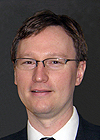Fermilab's new chief operating officer starts this summer
 |
|
Tim Meyer
|
This summer, Fermilab will welcome Tim Meyer as its next chief operating officer. Meyer is currently the head of strategic planning and communication at TRIUMF, Canada's national laboratory for particle and nuclear physics. He will succeed Vicky White, who will retire this summer after more than 30 years at Fermilab.
"Tim brings a broad set of experiences in laboratory operations, management and commercialization initiatives that map nicely into our vision for Fermilab," said Fermilab Director Nigel Lockyer. "He has an enviable track record in strategic planning, scientific public policy and affairs, and communications. Tim is credited with developing the strategy for the highly successful TRIUMF funding initiative with the government of Canada, the province of British Columbia and the Canada Foundation for Innovation. I anticipate that he will quickly have a big impact on the laboratory, and we look forward to his arrival."
As COO, Meyer will plan, direct and oversee Fermilab operations. He will help lead day-to-day laboratory management, help define the overall strategic direction for the lab and its performance expectations, and assess resource needs and priorities. Meyer will also develop and maintain strong relationships with DOE staff and other DOE laboratories.
Meyer is very familiar with Fermilab, having been a research assistant here after graduating from the Illinois Mathematics and Science Academy in Aurora. Since then he has visited the lab to give lectures and attend seminars.
"I owe much of my career to early inspiration from this great laboratory, and part of my job now is to return the favor and put my shoulder to the wheel," Meyer said. "I grew up in the Midwest, and moving back with my family to join Fermilab is a great honor."
Prior to TRIUMF, Meyer served as senior program officer at the U.S. National Academies, providing advice to the U.S. government on science and technology. He earned his Ph.D. in experimental particle physics from Stanford University studying the nature and time evolution of the bottom quark.
Meyer will arrive at Fermilab on June 2 and assume the role of COO on July 1.
—Deb Sebastian
Editor's note: Fermilab Today will publish a profile of retiring COO Vicky White and her contributions to Fermilab later this year.
|